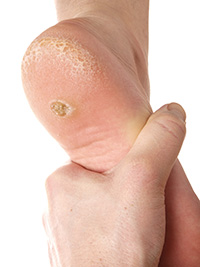What is a verruca?
Verrucae also known as warts are caused by a viral infection known as Human Papilloma Virus (HPV).
There are many different subtypes of HPV but the most common that affect the feet are known as plantar warts.
Depending on the subtype they can present differently in appearance. Quite often if they are on the bottom of your foot such as the heel or the ball they will develop hard skin over the top and there may be some mild discomfort when walking.
Corn vs verrucae
Although a corn and verrucae can present similarly to the naked eye, a corn is a concentrated area of hard skin usually caused by the biomechanics of your foot during gait when there is excessive pressure or friction.
Verrucae are a viral infection which invades the skin and on debridement have small brown or black specks caused by intravascular thromboses within its dilated capillaries. If in doubt it is important to see a health professional such as a Podiatrist before starting any treatment.
How did I get a verruca?
Human papillomavirus can survive months to years on surfaces. It is unlikely you will pass them on or pick them up from other people as the latest research suggests that the HPV that causes verrucae lives on our skin in harmony with other bacteria and virus strains and that a lowering of our immune system with mild illness such as colds; flu; stress or poor diet, can allow the virus to take up residence.
Contact with body fluids, except those directly from the plantar wart itself, does not transmit HPV. It is thought microtrauma of the epidermal skin barrier on the foot allows entry of the virus as well as hyperhidrosis (excessive sweating).
Once the virus enters the deep layers of the skin (the basal epitheal layer) there is a incubation period of 1 to 20 months, the immune system may fight the infection off or it will survive and develop into a plantar wart.
Why are they so difficult to treat?
Each person's immune system responds differently to HPV. Not everyone who comes into contact with it develops a verruca but once it has invaded the skin it is very clever as it can make itself undetectable.
The HPV strain that causes plantar warts aren't highly contagious. So the virus isn't easily transmitted by direct contact from one person to another. But it thrives in warm, moist environments. Anyone can develop plantar warts, but is more likely to affect children and teenagers, although they are less common in patients younger than 5 years young children can experience a steady increase in verrucae as they age until a peak incidence between 12 and 16 years of age.Other risk factors include; Individuals with weakened immune systems, ethnicity, environment, activities such as athletes/sports, history of verruca, nutrition/diet and trauma or injury to the skin.
Can they cause any problems?
Verrucae are benign lesions which mean they are not malignant (cancerous) growths, however if any new suspicious lesions occur on top or under the foot it is important you seek professional advice.
Verrucae are harmless and can resolve by themselves if left, however if they have been present for years it is unlikely they will go by themselves and treatment may be required, especially if the area is causing discomfort and affecting walking or daily activities.
Oral Zinc tablets
There is new research which looks into the link between zinc and resolution of plantar warts. Zinc is required by the body and is important in the normal function of the immune system. It is estimated around one-third of the world is deficient in zinc. The recommended daily intake is around 10mg for males and 7mg for females. It can be found in foods such as meat and eggs.
It has been found that zinc deficiency can adversely affect immune function and relating this to viral infections like HPV makes the individual more susceptible to plantar warts and the immune system fighting off the virus.
Treatment options and effectiveness
Over the counter products- which you can purchase from the chemist such as bazooka. These can be successful in verrucae which have not been present for long it is important to use them for up to 3 months as per instructions.
An option for younger children who aren’t finding the verruca painful and where the verruca hasn’t been present for long, may wish to leave the lesion to resolve via their own immune system fighting it off which decreases the risk of developing further verrucae later on in life.
Salicylic acid 60%- this is administered by Podiatrist who has access to this strength.
Cryotherapy- this is the process of freezing the wart using liquid nitrogen also administered by a podiatrist.
Needling - this is a minor surgical procedure, which involves the use of a fine needle to puncture the verruca lesion and dermo epidermal junction multiple times under local anaesthesia.
Swift microwave treatment- swift has a 74-76% resolution rate this is the highest success rate and is the ‘golden standard’ for verruca treatment now. Swift delivers a highly controlled microwave energy dose that rapidly elevates tissue temperature, the heat generated creates a highly accurate area of treatment, the treated tissue is then repaired, replaced and regenerated.
